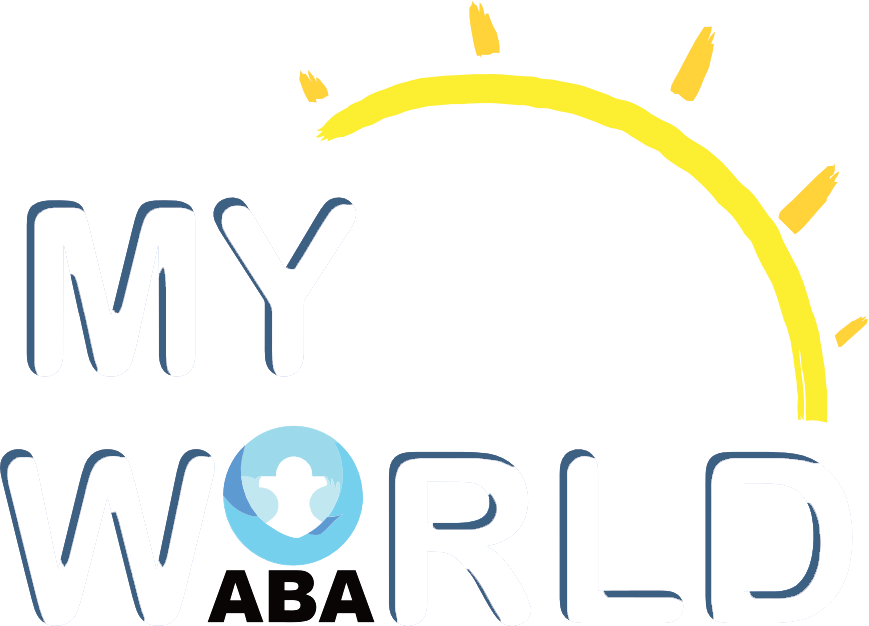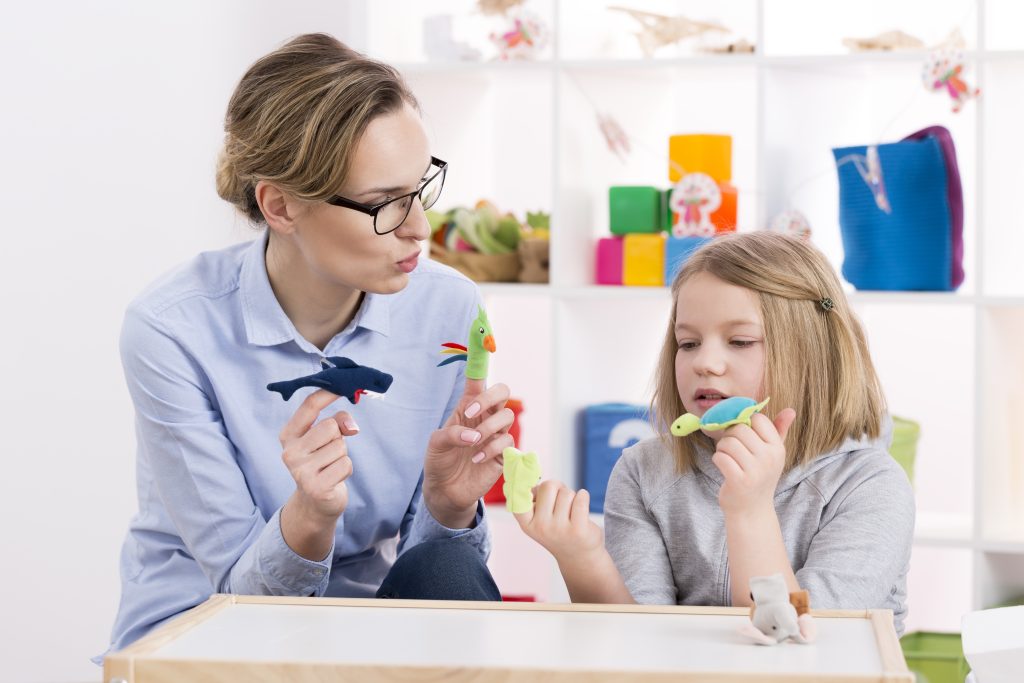Get the help your child with autism needs in Springfield, Ozark, or Joplin.
My World ABA firmly believes in evidence-based autism therapy, known as applied behavior analysis (ABA). This type of autism therapy uses a systematic approach to help your kiddo grow and mature.
Part of ABA therapy involves training your youngster to master verbal communication. The formal method is called verbal behavior intervention, which we explain in our comprehensive guide.
Table of Contents
What Is Verbal Behavior Intervention?
Verbal behavior intervention (VBI) is part of ABA therapy and emphasizes the function of language and why humans use words. It teaches people that words have a purpose, allowing them to get what they need or want. The aim is to teach functional communication so that people can effectively express their needs, wants, and ideas.
Functions of Verbal Behavior
Using verbal behavior intervention, we can teach children how to express their needs (make requests), label objects, repeat sounds (imitate), and respond appropriately, effectively, and naturally (have a conversation). We will create individualized plans that support meaningful progress based on the main functions of verbal behavior. This guide will discuss these functions in more detail.

Importance and Benefits of Functional Verbal Communication
Functional verbal communication empowers people to express their needs, thoughts, and emotions clearly and effectively. As children grow, they develop verbal communication skills that are more direct than nonverbal cues, such as pointing or crossing their arms.
Youngsters with autism may face challenges when moving from nonverbal to verbal communication. This is where verbal behavior intervention comes into play. Consider these benefits of functional verbal communication:
Improved Language Skills
Mastering verbal communication helps your child achieve independence, confidence, and stronger connections with others. Children who develop these skills feel more secure as they advocate for themselves when talking to others.
Relief for Parents and Caregivers
Parents and caregivers often feel immense relief when their children learn to communicate appropriately. Instead of guessing or interpreting unclear signals, they hear direct requests or observations. You might see reduced frustration on both sides. The family may be happier, too. Your youngster will gain control over their environment, reducing stress and preventing behavioral challenges stemming from miscommunication.
Enhanced Social Settings
Your child should feel more included and enjoy participating in social interactions with peers and adults. They’ll understand clear expressions, which encourages positive interactions and friendships. Kids who communicate well feel more comfortable joining group activities or conversations. Mastering these skills can lead to long-lasting connections, friendships, and close relationships.
Better Learning Environments
Children who clearly express questions or ideas are more active in classroom activities. Teachers can address concerns or misunderstandings right away, promoting a more dynamic and inclusive learning environment. Effective communication skills build a foundation for academic success and positive school experiences.
Improved Quality of Life
As children grow, their ability to communicate helps them develop relationships, independence, and self-advocacy. This is why teaching functional verbal communication early is crucial. It can prevent negative outcomes later.
Requests
As we stated, there are four main aspects to verbal behavior intervention. The first involves making requests.
Children use requests to communicate wants or needs, like asking for a favorite toy or a snack. Behavior technicians encourage requests through positive reinforcement when kids make attempts at communication, even when they appear imperfect. The goal is to build confidence while helping youngsters understand the power of words.
For example, rather than pointing at a cup of water, your youngster might simply say, “Water!” The behavior technician would give your kiddo the cup and reinforce the behavior. The goal would be to eventually have your youngster say, “Can I have water?”
Labeling
Labeling or describing items, actions, or characteristics, is another part of verbal behavior intervention. A child might point to a ball and say, “ball,” or describe the color of a car. Behavior technicians teach labeling to help kiddos expand their vocabulary and engage more actively with their surroundings.
It is extremely important to do this in a familiar setting, like at the dinner table, around the house, at a favorite park, and grocery shopping. There are many things to point out at these places, creating hundreds and even thousands of opportunities for labeling.
Imitation
Imitation is just like it sounds. We might also use the word “modeling” rather than imitation. The goal is to get your child to repeat sounds or words. This skill supports pronunciation and language acquisition. Your child should develop clearer, more accurate speech patterns to foster a better understanding of their needs.
Behavior technicians at our clinic model words or phrases and then encourage repetition. We always employ positive reinforcement when children make a successful attempt. For example, we might ask your kiddo, “May I have the red block?” And then, we would say, “Okay, now you ask me for the red block.”

Conversational Skills
Children learn to answer questions or respond to statements as part of learning how to communicate.
Behavior technicians use these exchanges within everyday conversations. We’ll teach youngsters to link words contextually. The goal is to give your kiddo the confidence to participate actively in communication with others.
For example, we might ask your child, “What color is the sky?” The answer would be “Blue.” Then, we would relate that to something else about the sky, “What flies in the sky?” Depending on the answer, like a bird, plane, or helicopter, we would proceed with the conversation.

Implementing Verbal Behavior Intervention at Home
We encourage all parents and caregivers to use verbal behavior intervention at home, where your child feels the most at ease.
Creating a Language-Rich Environment
We highly recommend surrounding your youngster with verbal input throughout daily routines. Narrating activities, labeling objects, and using simple, consistent language help your kiddo connect words with actions. For example, during snack time, you might say, “Juice. Pour juice into the cup.” The idea is to encourage word associations and functional language use.
Use picture cards or labeled objects as visual supports to enhance understanding and reinforce language concepts. These work well if your child is a visual learner. Placing visual cues around the home helps your child connect spoken words with corresponding written words, items, or actions.
Conducting Sessions
In addition to everyday activities, you can set aside structured sessions whenever it’s appropriate for your schedule. Once a week might work for some families. Monthly might work for others. Aim for targeted goals, such as requesting favorite items or labeling household objects. Break tasks into small, manageable steps to prevent being overwhelmed. Motivational tools and positive reinforcement keep your youngster engaged.
Offer praise, smiles, or preferred items immediately after successful attempts as a form of positive feedback. Using positivity and encouragement strengthens the connection between communication efforts and positive outcomes. Keep sessions brief yet consistent to maintain your youngster’s focus.
Analyzing Progress
We encourage you to track verbal communication attempts, noting progress and challenges as you go. Written logs or digital apps can help you identify patterns and areas that might need improvement. You can adjust your own plan accordingly.
Make sure to reflect on the effectiveness of when you reinforce your child’s behaviors. Does the reinforcement motivate your youngster? Do prompts or cues assist or hinder communication?
Age-Appropriate Activities for Verbal Behavior Intervention
One key to success at home is to have age-appropriate activities.
Toddlers (1–3 years)
- Song repetition, like singing simple songs such as “Twinkle, Twinkle, Little Star” and pausing to let your toddler fill in a word or sound.
- Snack time requests where you hold a favorite snack and prompt your kiddo to say “more” or name the snack.
- Animal sounds is an activity where you show pictures of animals and prompt your youngster to name or imitate the sounds.
- Peek-a-boo with words where you say “peek-a-boo” and wait for your child to repeat or respond, building anticipation and vocal imitation.
Preschoolers (3–5 years)
- I spy games use simple phrases like, “I spy something red,” and encourage your youngster to label objects.
- Requesting art supplies occurs when you set up a craft activity and prompt your child to request each item by name or color.
- Story time with questions follow up with reading a book or story. Ask simple “what” or “who” questions to encourage responses.
- Echo repetition games happen when you say a phrase like, “Ready, set, go!” and prompt your kiddo to repeat each word.
School-Age Children (6–10 years)
- Conversation starters use cards with simple questions or prompts to encourage back-and-forth dialogue.
- Scavenger hunts give clues that include descriptive words, prompting your child to label found items.
- Role-playing games set up scenarios (like ordering at a pretend restaurant) to practice polite requests.
- Rhyming word challenges let you say a word and have your youngster come up with a rhyming word, promoting verbal flexibility.
Adolescents (11+ years)
- Debate practice is where you choose lighthearted topics and encourage your kiddo to express opinions or argue a point.
- Storytelling activities: Prompt your child to narrate personal experiences or create imaginative stories.
- Descriptive pictionary is when your pre-teen or teenager describes a drawing without showing it to others, encouraging precise language.
- Peer conversation skills to practice conversational turn-taking and responding to questions or comments.
Challenges of Verbal Behavior Intervention
Verbal behavior intervention has many benefits. But it may also come with challenges. Talk to us about overcoming these challenges, and we’ll present you with some tips and techniques to help.
1. Skill Generalization
You want to help your child apply their skills across different environments and situations. Your youngster might successfully use a word or phrase during a therapy session but struggle to use it at home or school. Use varied scenarios to help your child develop communication skills in as many situations as possible.
2. Maintaining Motivation and Engagement
Keeping your kiddo motivated during formalized sessions might be challenging. Sometimes, making them short doesn’t work. It might be easier to have fewer formal sessions and keep things consistent when natural settings arise.
3. Balancing Prompting and Independence
When should you stop prompting your child and let them communicate independently? Too many prompts can lead your youngster to depend on these things. You might notice they wait for cues instead of initiating communication. You must learn how to gradually diminish prompting and encourage independent communication.
4. Measuring Progress Accurately
Tracking improvements can be tricky. It might seem your child isn’t moving along as you’d expect. There may be good days and days that aren’t as successful. The key is learning to recognize and note subtle changes in communication attempts while accounting for variability in your child’s behavior. Clear, measurable goals can help you recognize small steps of improvement while maintaining realistic expectations.
Help Your Child With Autism to Grow
We believe every child is unique, and we want your youngster to get the most out of life. To learn more about our services or answer additional questions, contact us online or call (417) 818-5784 today.
We have offices in Springfield, Ozark, and Joplin, Missouri.




